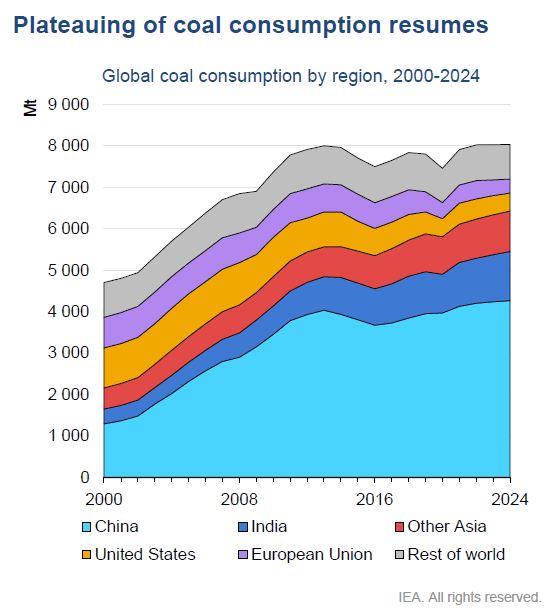So much for the End of Coal
It’s a bumper year in 2021, a bigger year in 2022, and possibly more glorious records for coal in 2023 and 2024. Humans burnt more coal last year than at any other time in history.
Coal-fired power generation is set to reach an all-time high in 2021
The declines in global coal-fired power generation in 2019 and 2020 led to expectations that it might have peaked in 2018. But 2021 dashed those hopes. With electricity demand outpacing low-carbon supply, and with steeply rising natural gas prices, global coal power generation is on course to increase by 9% in 2021 to 10 350 terawatt-hours (TWh) – a new all-time high.
As the IEA concludes through gritted teeth: Global coal consumption is not on the Net Zero trajectory and is unlikely to be before 2024. Perhaps someone should tell all the Glasgow Minions?
Other editors might have labelled this, “Coal Still Vital” or “Coal’s Day is Here”! Instead the IEA saw a sedate plateauing that kept plateuing in the headlines:

Fully two-thirds of global coal is used by just two countries. The other 193 nations split the last third. Many of these other nations are the same ones fighting hard to make tiny reductions in their coal use in the quest for fashionable weather-purity.
Indeed, one third of all the coal on Earth is used to make electricity in China
Power generation in China alone is responsible for almost one-third
of global coal consumption. No other sector in any other country –
or any other fuel – has a comparable influence on global trends.
Communist planning still doesn’t work
In the third quarter of 2021, an imbalance between coal supply and demand became apparent when coal producers were unable to keep up with surging demand (see also the Supply chapter). The shortage’s effects were exacerbated by China’s rigid electricity tariff system. Because Chinese electricity prices are regulated, they do not follow coal prices. Therefore, as coal prices rose and electricity prices remained rigid (they could oscillate only 10% from the benchmark price, although this was reformed in October to allow a higher range), coal-fired power producers had no incentive to secure sufficient coal.
And then there was pain in China. Imagine power cuts and production losses of 70 – 80%? And these were not pandemic losses, just bad planning:
In mid-2021, China began to curtail industrial activity in some
provinces as coal supplies and imports were unable to keep up with
demand. In September, power rationing for industrial consumers
occurred in 20 provinces. In Guangdong province, for example,
manufacturers of ceramic products experienced power cuts of up to
70%, and Yunnan province ordered cement producers to cut
production by 80%. Similar measures – and even complete power cuts – affected aluminium, steel and other energy-intensive industries all over China. In Heilongjiang, Jilin and Liaoning, even residential consumers were affected as power supplies fell short of demand by as much as 20% at times.
“coal’s share of the global power mix in 2021 is expected to be 36%”
REFERENCE
Coal 2021, IEA, https://www.iea.org/reports/coal-2021, the press release.